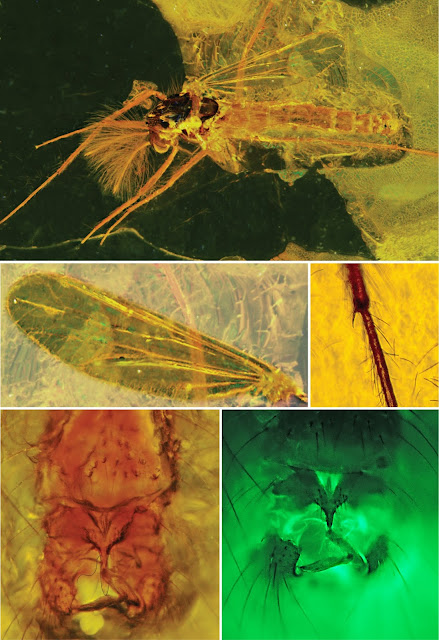When you start
studying fossil insects which are 40 million years old, you expecting them to be,
well, a little bit different from what surrounds you right now. But midges from
the fossil amber, they stand still, and hold the line, untouched by time passage
so distant from the present time, so close to the other midges flying over yours
garden pond.
Non-biting midges
(Diptera, Chironomidae) are everywhere from high Arctic to Antarctic Peninsula (which
makes them most widespread holometabolic insects in the world). They taking part
in pretty much every ecological process you can think about. With 7000 described
species populating all possible aquatic habitats they are perfect model species
for the bioindication, biogeography, space studies, suspended animation
research etc. This is also very old group, first appeared in the geological record
around 210 million years ago. Non-biting midges are making sometimes up to 80% of
all animal fossils in the amber.
Baltic amber forest, was growing in the delta of the gigantic river lying on the ground of modern Poland and Baltic States. This subtropical forest, full of conifers, magnolias and tree ferns, was covering most of the Central and North –Eastern Europe during period of 40-33 million years ago. It was growing in the world without polar ice caps, tropical forests and African savannas. Climate was much more equal lacking cold or tropical extremes. But in this much different world same midges as now were thriving, the same Smittia, Bryophaenocladius, Phaenopsectra and Chaetocladius which are flying over the British streams or German ponds today (Fig.1). There are proofs that not only eocenic midges looks like modern, they also share an ecological niches.
Fig. 1. This remarkably preserved Bryophaenocladius beuki, is looking like an any normal nowadays midge, albeit being in amber for more than 36 million years ago! Photo is from our recent paper in the Norwegian Journal of Entomology.
I was lucky
to find a first (and so far only) pupa of the non-biting midge from Baltic amber
(from Rovno, Ukraine) (Fig.2). Pupa is looking alike modern genus Smittia and possessing characters of terrestrial
dwelling non-biting midges, exactly the same as Smittia have. That means that eocenic Smittia just like modern was dwelling at the moisture soil and mosses.
They have survive disappearance of the Baltic amber forest, cooling of the Northern
Europe up to 60 consequent glaciation and even rise of the humans without changing
their habitats and adaptations.
Fig. 2. Chironomid pupa from Rovno amber. Overview. Scale bar: 200 µm. Photo by Dr. Tomasz Goral (LNHM, London, UK). Photo is from our recent paper on fossil chironomids published in "Geobios"
Some palaeontologists
are claiming that high survival rate of the non-biting midges genera over geological
epochs is due to the amphibious nature. Larvae and pupa of vast majority of non-biting
midges are aquatic and aquatic habitats are believed to be more stable than terrestrial.
But if we will take a look on the midges from cretaceous ambers and compression
fossils, they were different from recent one and only having glimpse of similarities
with some relict modern midges, which still living in the parts of old Gondwanaland
- Australia, Terre del Fuego, New Zealand.
Whatever wiped
out the dinosaurs from the Earth, it is also shaped modern communities of non- biting
midges, which are maintained through the last 50 million years or so. Something
has changed on the border of Cretaceous and Paleogene. Some believes that it was
emergence of the modern type vegetation, replacing Mesozoic conifer and fern-dominated
forests. The great game-changer was introduced, and his name was… leaf litter. Yes,
leaf litter is a main source of the external organic matter for many of modern lakes
and rivers. However, it was totally alien in the late Cretaceous. Possibly high
levels of organics from decaying leaf litter in the lakes and rivers have wiped
out established communities of the Mesozoic midges, sending them into the oblivion
alongside with dinosaurs. After the Cretaceous extinction chironomid communities
were stable until now.
In the midst
of the Sixth Extinction – man-caused biosphere crisis, which is unfolding right
now – such resilience, gives hope that they can survive us too. Unless we will become
another great game changer, as leaf litter or Chicxulub meteorite were once. If
it happens, than Chironomidae communities will drastically change for the first
time, since dinosaurs’ extinction and the rest of the world will change with them.


No comments:
Post a Comment